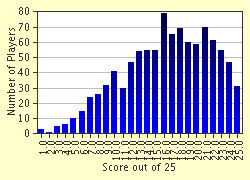Quiz Answer Key and Fun Facts
1. A is for ABERTAWE. Abertawe is the Welsh name of a city in Wales. By what name is it known to English speakers?
2. B is for BLENHEIM PALACE, one of the stateliest of all the stately homes of England. Who lives there?
3. C is for CHIPPERFIELD. With which form of popular entertainment is the Chipperfield family associated?
4. D is for DEBRETT. What would you expect to find in the principal reference book published by this firm?
5. E is for ENGLAND, which is not the same thing as Great Britain or the United Kingdom. Approximately what fraction of the population of the UK lives in England?
6. F is for FOOTBALL, which in the USA means soccer. Football is probably the most popular spectator sport in the UK and we know little about baseball; but for more than a hundred years one football club played its home games at the Baseball Ground. Which club?
7. G is for GLASGOW, the largest city in Scotland. Glasgow is the home of two celebrated football clubs which are known as "the old firm". Which clubs are they?
8. H is for HOLIDAYS. Britain has fewer public holidays than many European countries, and they vary from one part of the UK to another. Which of the following is NOT a public holiday in any part of the UK?
9. I is for ISAMBARD KINGDOM BRUNEL, one of the UK's greatest engineers. Which of the following was NOT his work?
10. J is for "JERUSALEM", a visionary poem set to music by Sir Hubert Parry, and sung enthusiastically by members of Women's Institutes and by the audience at the last night of the Henry Wood Promenade Concerts in the Royal Albert Hall. Who wrote the poem?
11. K is for KENT, the closest part of the UK to continental Europe. Where in Kent is the seat of the principal archbishop of the Church of England?
12. L is for LONDON. Greater London covers more than 600 square miles (1,550 square kilometres), but what is the approximate area of the district properly called the City of London?
13. M is for MONEY. In which year did the UK adopt decimal currency?
14. N is for NEWMARKET, a town in Suffolk on the Cambridgeshire border. With which sport is it particularly associated?
15. O is for OXFORD UNIVERSITY, the oldest in the UK. Many of our Prime Ministers went to Oxford, but it's possible to get to the top without an Oxford education. Which of the following Prime Ministers was NOT educated at Oxford?
16. P is for PUB. one of the commonest pub names in Britain is derived from the royal arms of Scotland. What is it?
17. Q is for QUEENSBERRY. In 1867 the 8th Marquess of Queensberry played a part in drawing up the rules for which sport?
18. R is for RUGBY. Both rugby codes (Union and League) are played in the UK. Which one of the following is a Rugby League club?
19. S is for SCOTLAND. On the death of Queen Elizabeth I of England in 1603, King James of Scotland succeeded to the English throne. What were his regnal numbers?
20. T is for THAMES, the second longest river in Great Britain and the longest wholly in England. Which one of these towns is NOT on the Thames?
21. U is for ULSTER. This name is often used in the UK as an alternative name for Northern Ireland, but the two are not the same. Which of these counties of Ulster is NOT part of Northern Ireland?
22. V is for VICTORIA, the second-longest reigning British monarch, whose name is seen everywhere in the UK. Which of the following will you NOT find in London?
23. W is for WHISKY, one of the many Celtic contributions to human happiness. Which Scottish island produces Lagavulin, Laphroaig, Bruichladdich, Bowmore and Ardbeg single malt whiskies, among others?
24. Y is for YORK, an ancient city packed with history. Which of the following is NOT one of the attractions of York?
25. Z is the last letter of the alphabet. How is its name pronounced in the UK?
Source: Author
TabbyTom
This quiz was reviewed by FunTrivia editor
ozzz2002 before going online.
Any errors found in FunTrivia content are routinely corrected through our feedback system.


